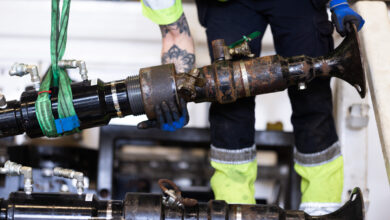BP/Maersk look outside industry to develop HPHT drilling technology
By Astrid Wynne, contributing editor

A partnership between BP and Maersk Drilling to develop conceptual engineering designs for HPHT drilling technology is looking beyond industry norms. “Higher pressure can be taken care of with more steel, to put it in simple terms, but the high temperatures have implications on the seal technology within the risers, the material technology inside the BOP and the rams to take the high temperatures. That’s where we might have to look a little bit outside our industry for solutions,” Frederik Smidth, chief technical officer at Maersk Drilling, told Drilling Contractor.
As the project is just beginning – the two companies announced their partnership agreement in February – much still needs to be explored. However, Mr Smidth said he already sees that one major challenge will be to create a reliable package for HPHT, even if certain technology components are already available. Major vendors, for example, have development of 20,000-psi well control equipment and driller risers under way.
“I see the main challenge is to get the full well control package safe and efficient to operate. We will need a hookload capacity beyond the current 2.5 million lbs for these types of wells, but the challenge is finding the well control and lifting structure equipment and the flexible hoses and connections used in the drilling system.”
Under Maersk’s agreement with BP, the initial studies will outline the basic design criteria, such as hookload capacity and the vessel size and type that will be capable of operating in a 20,000-psi and 350◦F environment, as well as the safety systems needed to protect and train crews. Phase 1 of the project is expected to last approximately one year, with a potential extension into a contract for a finalized design that could culminate in an order by late 2015 or early 2016.
“The first units would begin drilling the US Gulf of Mexico (GOM) in 2018 or 2019, with possible additional requirements in Egypt and Azerbaijan if a contract is awarded,” Mr Smidth said.
He added that this joint project with BP is also providing Maersk Drilling with valuable insight into the deepwater cost structure from an operator’s perspective. Knowledge found within BP’s deepwater well database, for example, is helping Maersk to design systems to reduce nonproductive time.
“The total cost of drilling a deepwater well in the US GOM is around $1.2 to $1.3 million a day. We, as the drilling company, account for only 50% of the costs for an oil company,” Mr Smidth explained. “It is interesting to understand the other half of those costs, like for example the 30% to 40% nonproductive time when drilling deepwater wells. We expect to gain a knowledge that can be used in more traditional rig designs. The aim of the process is to build rigs which are safer, faster and cheaper to operate.”
Going forward, Mr Smidth sees the potential for more collaborative technical projects between drilling contractors and oil companies. “For the new frontiers – 20k, Arctic Sea, Barent Sea, the high H₂S drilling in the northern Caspian – I think this kind of cooperation is essential. Drilling costs are increasing, and we can only reduce them by understanding each other’s cost structure.”





Hi Dr.
I thought you may be interested in this article.
Thanks for the class. I really enjoyed it.
Octavio Alvarez
Saudi Aramco